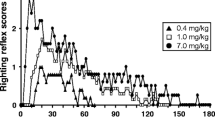Abstract
The anxiolytic profile of dexmedetomidine, a novel, highly-selective α2-adrenergic agonist, was examined in rats in the elevated plus-maze test when administered either alone or in combination with the benzodiazepine agonist midazolam. Dexmedetomidine, 0.1–10 µg/kg, was inactive in modifying the rats' behavioral response in this test. Midazolam, 0.1–10 mg/kg, dose-dependently produced an anxiolytic-like profile characterized by an increased time spent in the open arms of the elevated plus-maze. A combination of dexmedetomidine 0.5 µg/kg and midazolam 0.5 mg/kg produced a synergistic interaction. This heterergic interaction of dexmedetomidine on midazolam's anxiolytic-like profile was dose-dependently blocked by pretreatment with an α2-adrenergic antagonist, atipamezole, 10–50 µg/kg, and a benzodiazepine antagonist flumazenil, 1.0 and 10 mg/kg, but not by the α1-adrenergic antagonist, prazosin, 0.1–10 mg/kg. While the transmembrane signal transduction pathways for benzodiazepine- and α2-agonist responses do not share any molecular component, there does appear to be “crosstalk” between these two systems. These may involve GABA or noradrenergic “downstream” effects of either dexmedetomidine or midazolam, respectively.
Similar content being viewed by others
References
Berenbaum MC (1989) What is synergy? Pharmacol Rev 41:93–141
Bylund DB (1989) Subtypes of α2-adrenoceptors: pharmacology and molecular biological evidence converge. TIPS 9:356–361
Costa E, Guidotti A, Mao CC, Suria A (1975) New concepts on mechanism of action of benzodiazepine. Life Sci 17:167–186
Doze VA, Chen B-X, Maze M (1989) Dexmedetomidine produces a hypnoticanesthetic action in rats via activation of central α2-adrenoceptors. Anesthesiology 71:75–79
Gentsch C, Lichtsteiner M, Feer H (1987) Open field and elevated plus-maze: a behavioral comparison between spontaneously hypertensive (SHR) and Wistar-Kyoto (WKY) rats and the effects of chlordiazepoxide. Behavioral Brain Res 25:101–107
Guo TZ, Tinklenberg J, Oliker R, Maze M (1991) Central alpha 1-adrenoceptor stimulation functionally antagonizes the hypnotic response to dexmedetomidine, an alpha-2 adrenoceptor agonist. Anesthesiology 75(2):252–256
Handley S, Mithani S (1984) Effects of alpha-adrenoceptor agonists and antagonist in a maze-exploration model of “fear”-motivated behavior. Naunyn-Schmiedeberg's Arch Pharmacol 327:1–5
Jack ML, Colburn WA, Spirt NM, Bautz J, Zanko M, Horst WD, O'Brien RA (1983) A pharmacokinetic/dynamic/receptor binding model to predict the onset and duration of pharmacological activity of the benzodiazepines. Prog Neuropsychopharm Biol Psychiatry 7:629–635
Maze M, JW Regan (1991) Role of signal transduction in anesthetic action of α2-adrenergic agonists Ann NY Acad Sci 625:409–422
Onaivi ES, Green MR, Martin BR (1990) Pharmacological characterization of cannabinoids in the elevated plus maze. J Pharmacol Exp Ther 253[3]:1002–1009
Pellow S, Chopin P, File SE, Briley M (1985) Validation of open: closed arm entries in an eleveted plus-maze as a measure of anxiety in the rat. J Neurosci Methods 14:149–167
Pittaluga A, Raiteri M (1988) Clonidine enhances the release of endogenous gamma-aminobutyric acid through alpha-2 and alpha-1 presynaptic adrenoceptors differentially located in rat cerebral cortex subregions. J Pharmacol Exp Ther 245:682–686
Rägo L, MacDonald E, Saano V, Airaksinen M (1990) The effect of medetomidine on GABA and benzodiazepine receptors in vivo: lack of anxiolytic but some evidence of possible stress — protective activity. Pharmacol Toxicol 69:81–86
Salonen M, Reid T, Maze M (1991) Hypnotic synergistic interaction between α2-agonists and benzodiazepine in rat. Anesthesiology 75:A1125
Söderpalm B, Engel JA (1988) Biphasic effect of clonidine on conflict behavior: involvement of different α-adrenoceptors. Pharmacol Biochem Behav 30:471–477
Söderpalm B, Engel JA (1990) α1- andβ-adrenoceptor stimulation potentiate the anticonflict effect of a benzodiazepine. J Neural Transm 79:155–167
Stein L, Belluzzi JD, Wise CD (1977) Benzodiazepines: behavioral and neurochemical mechanisms. Am J Psychiatry 134:665–670
Uhde TW, Stein MB, Vittone BJ, Siever LJ, Boulenger JP, Klein E, Mellman TA (1989) Behavioral and physiologic effects of short-term and long-term administration of clonidine in panic disorder. Arch Gen Psychiatry 46:170–177
Yang XM, Luo ZP, Zhou JH (1988) Behavioral evidence for the role of noradrenaline in putative anxiolytic and sedative effects of benzodiazepines. Psychopharmacology 95:280–286
Author information
Authors and Affiliations
Rights and permissions
About this article
Cite this article
Salonen, M., Onaivi, E.S. & Maze, M. Dexmedetomidine synergism with midazolam in the elevated plus-maze test in rats. Psychopharmacology 108, 229–234 (1992). https://doi.org/10.1007/BF02245313
Received:
Revised:
Issue Date:
DOI: https://doi.org/10.1007/BF02245313




